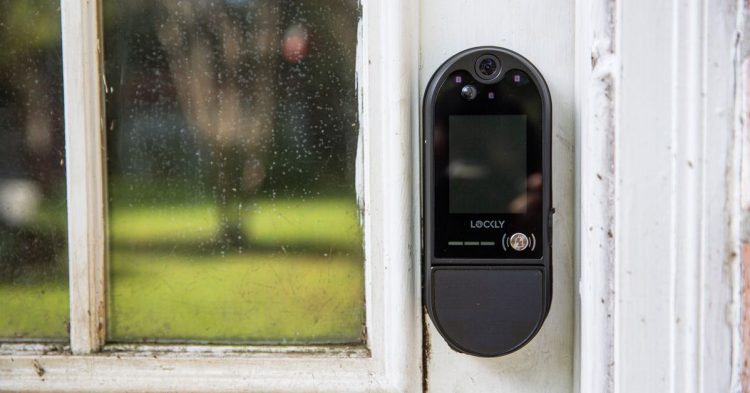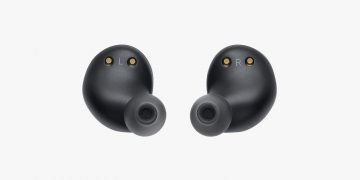It’s big, bulky, and has a design that bellows “I am a high-tech door lock,” but the $499 Lockly Vision Elite packs a lot of function into its sizable frame. A smart lock and video doorbell in one, it’s designed for someone who wants both of those things but doesn’t have the space or setup to install two large gadgets on their front door.
However, cramming a video doorbell into a smart lock was bound to come with compromises, and while this is an excellent smart lock, it’s only an okay video doorbell — chiefly because its motion detection is spotty, and there’s no people or package detection. Also, while Lockly includes a little sign telling visitors to press the button on the door lock, no one is going to ring your door lock.
Lockly Vision Elite
$499.99
The Good
- Two-in-one
- Lots of ways to unlock
- Two rechargeable solar-powered lithium-ion batteries
- Local video storage
- No subscription fee
- Lock works with Alexa and Google
The Bad
- No one is going to ring your door lock
- Motion-triggered video recording is unreliable
- Incredibly expensive
- Hub requires ethernet
- No smart home integration for the doorbell
How we review and rate products
The Vision Elite is a full deadbolt replacement lock that boasts an almost absurd number of features. In addition to the built-in camera, it has an integrated door sensor that can tell you if it’s open and no fewer than five ways to unlock your door: an integrated keypad; a fingerprint reader; the Lockly smartphone app; voice control using Amazon Alexa or Google Assistant; and of course, a regular key.
It doesn’t have NFC communication to support Apple Home Key (it doesn’t support HomeKit at all), and there’s no auto-unlocking as you approach, but there are plenty of options here.
You can create and share digital keys through the app, though your visitor has to download the Lockly app to use them. If they don’t want the hassle and you’re not at home, you can generate an “offline” keycode for them and revoke it at any point.
The Lockly Vision Elite features an integrated video doorbell, and it has a solar panel over the keyhole.
The keypad also has what Lockly calls “PIN Genie” technology: three numbers in every touchpoint. This makes it impossible for anyone peeking over your shoulder to guess your code. You can also set it to random mode so the buttons change every time. This does make it harder to input your code, though, as you have to hunt for the numbers each time.
The PIN Genie keypad is designed to confuse lookie-loos.
An integrated doorbell camera sits above the keypad. When a visitor presses the doorbell button (situated below the keypad), the lock emits a loud “ding dong,” and the app sends an alert. From here, you can view a live feed and control the door lock from the same screen, a feature only a few other video doorbells offer. Ring has the option with its video doorbells and certain smart locks, and Apple HomeKit can, but only if both the smart lock and video doorbell are HomeKit-compatible.
There’s also no subscription to view recorded video from the doorbell camera since the footage is stored locally on an included hub. Ring, Nest, and Arlo charge from $3 to $6 a month to see recorded video. The hub, which has to be connected to your router with an Ethernet cable, can hold up to 91 hours of video on its 32GB of non-expandable storage, and it acts as a Wi-Fi bridge for out-of-home control and smart home integrations. It works with Amazon Alexa and Google Home but not Apple HomeKit. Lockly says it is working on plans to support Matter.
While this is a great smart lock, it’s not a great video doorbell. It’s just okay. Which, considering it’s squeezed into a door lock, isn’t that surprising. It’s also the best video doorbell / lock combo you can get right now — the only other option is this lock’s predecessor, the Lockly Vision. I tested that a couple of years ago and was unimpressed with the doorbell features then.
The Lockly app opens to the lock control; tapping on the video image takes you to the live feed, where you get controls to lock / unlock the door and talk to the visitor.
This model is better — with a much-improved camera (1080p HD) and a portrait aspect ratio for a top-to-bottom view that gets both packages and people. The audio is also clear and full-duplex, like a phone call and not a walkie-talkie, and there’s now infrared night vision.
Plus, Lockly added motion detection, so it will record when someone comes up to your door but doesn’t press the button. (The earlier version only recorded when someone pressed the button.) This means that if your delivery driver just drops and runs and you miss the motion notification the app sends, you will still get a recording of the event.
This is the best video doorbell / lock combo you can get right now
But there is no people or package detection, a feature on most other video doorbells, meaning you’ll have to check the notification every time. This issue is compounded by Lockly’s software, which is very slow; videos took upwards of 10 minutes to show in the app.
Speaking of software, there are some other issues. Motion detection and motion-activated recording didn’t work at all for me at first. Lockly suggested setting the motion detection notification in the app to zero-second Motion Duration (it’s on 5 seconds by default); this worked for a while but then recording on motion stopped again. You can set it to record video whenever someone unlocks the door by fingerprint or code, and that did work.
Lockly expects you to put this sign near your door.
Any video recording cuts off after 30 seconds, followed by a 10-second retrigger time during which it won’t record again. This is to save battery life, but I’d like the option to record longer and more frequently if I want. And while it supports two-way audio, the camera only records the visitor’s audio, not yours.
The other problem is that there’s no option for an indoor chime. The doorbell itself rings inside the house, and quite loudly, but it was easy to miss if I was upstairs. You can’t connect it to an Alexa or Google Home speaker to amplify the chime, either; nor can you change the sound it makes.
These issues aside, it works well as a basic video doorbell. The app opens quickly when you respond to a notification and takes you directly to a live feed of your doorstep. If you miss a call, the video is stored in the app’s log (although, as noted, not immediately).
The fingerprint reader doesn’t leave much room if your doorjamb is on the same side.
Battery life is a big issue with door locks, and I’d expect one that includes both a video camera and motion sensor to run out fairly quickly. I couldn’t drain the battery in my almost two weeks of testing, and a built-in solar panel on the lock’s key cover will trickle charge the battery, but it’s very small and would need a lot of sunlight to make much impact. I do love that the Lockly Vision Elite uses rechargeable batteries, includes a second one in the box, and that both batteries charge via a USB-C cable that’s also included.
You’ve got no excuse for running out of battery here, but if you do, you can use a 9V battery to jolt it back to life from the outside long enough to use the keypad or fingerprint reader (assuming you don’t have the key).
Installation includes hooking up various power and data cables from the inside of the lock to the keypad and doorbell camera.
Installation was only slightly more complicated than a standard full replacement smart lock, as there are some cables you have to connect between the exterior and interior portions of the lock. Setting up access codes and fingerprints in the usable (but cluttered) app was straightforward. The app walks you through pressing your digit to the fingerprint reader to log your print and assign it to a person. Both fingerprint and code unlock were reliable and worked quickly, as did using the app. The log in the app shows you when and how the lock was operated, as well as by whom, and the push notification also gives you this info.
One word of caution: the fingerprint reader is on the right-hand side of the lock, and if your doorjamb is also on the right side, you may struggle to get your finger onto the reader. I had this issue when I tested the original Lockly Vision, so this time, I installed the lock on my back door, which has a bit more space so I could use the fingerprint reader. My back door also gets direct sunlight. If you have a covered porch, the solar panel isn’t going to do you much good.
The Lockly has an auto-lock feature, or you can swipe across the screen or tap a button to lock it from the outside. There’s a scheduling feature in the app, and you can connect to Amazon Alexa to lock it every night at a specific time or as part of a Routine. It also works with Google Home for voice control of the lock using a PIN. The video doorbell has no smart home integration, so you can’t pull up a live feed on an Echo Show or Google Nest Hub display like you can with most standalone video doorbells.
A magnetic door sensor is built into the deadbolt — indicated by the red dot.
Smart home data privacy: Lockly Vision Elite
Bringing connected devices into your home also brings with it concerns about how the data they collect is protected. The Verge asks each company whose smart home products we review about what data it collects and the safeguards in place for that data.
The primary data a smart door lock collects is when you lock / unlock the door and how (keypad, manually, with the app, etc.). A video doorbell also collects video and audio footage. Lockly says all footage generated by the video doorbell is stored locally, and it has no access to it at any point.
To use Lockly’s app, you must sign up for an account and provide personal details, including name, email, address, and phone number. Lockly says all data it collects from the app is encrypted in transit and is transferred over a secure connection. In addition to using the data to improve the device’s function, Lockly says it may use personal information for “auditing, data analysis, and research.” Lockly doesn’t have the option to opt out of data sharing without impacting the lock’s functionality.
You can read the full Lockly Privacy Policy here.
The Lockly Vision Elite is a good smart lock but a basic doorbell, and for around $500, you can buy a great smart lock and a great video doorbell. Lockly sells a non-camera version of its smart lock for $300 or a fingerprint-only version for just $160; add a Ring Video Doorbell 4 for $220 (or the Ring Pro 2 if you have doorbell wires), and you get a lot more function from your doorbell, including viewing footage on a smart display and people and package detection.
With Ring, you need to pay a subscription fee for video recording. If that’s a deal-breaker, Eufy offers both fingerprint-enabled smart locks and video doorbells with no subscription fees and is launching its own two-in-one video doorbell smart lock for $400 later this year. If you’re not interested in fingerprint unlocking, Schlage, Yale, and Kwikset have good smart locks for under $300.
But if you have limited space on your front door to fit multiple smart devices, no doorbell wiring, and you only really care about the people that ring the doorbell and not anyone or anything else that might skulk around your front porch, the Lockly Vision Elite will do a good job.
Photos by Jennifer Pattison Tuohy / The Verge
Agree to continue: Lockly Vision Elite
Every smart device now requires you to agree to a series of terms and conditions before you can use it — contracts that no one actually reads. It’s impossible for us to read and analyze every single one of these agreements. But we started counting exactly how many times you have to hit “agree” to use devices when we review them since these are agreements most people don’t read and definitely can’t negotiate.
To set up the Lockly Vision Elite lock, you must download and the Lockly app and create an account. By doing so, you need to agree to the following:
Finally tally: three mandatory agreements.
Source by www.theverge.com

























%2Fcdn.vox-cdn.com%2Fuploads%2Fchorus_asset%2Ffile%2F24015496%2F226262_LOCKLY_VISION_ELITE_PHO_jtuohy_0008.jpg&w=2400&q=75)
%2Fcdn.vox-cdn.com%2Fuploads%2Fchorus_asset%2Ffile%2F24017436%2F8A0A6287.jpeg&w=2400&q=75)
%2Fcdn.vox-cdn.com%2Fuploads%2Fchorus_asset%2Ffile%2F24022859%2Fscreenshots_copy.jpg&w=2400&q=75)
%2Fcdn.vox-cdn.com%2Fuploads%2Fchorus_asset%2Ffile%2F24023052%2FLockly_Vision_Elite_sign.jpg&w=2400&q=75)
%2Fcdn.vox-cdn.com%2Fuploads%2Fchorus_asset%2Ffile%2F24015497%2F226262_LOCKLY_VISION_ELITE_PHO_jtuohy_0009.jpg&w=2400&q=75)
%2Fcdn.vox-cdn.com%2Fuploads%2Fchorus_asset%2Ffile%2F24015490%2F226262_LOCKLY_VISION_ELITE_PHO_jtuohy_0002.jpg&w=2400&q=75)
%2Fcdn.vox-cdn.com%2Fuploads%2Fchorus_asset%2Ffile%2F24015493%2F226262_LOCKLY_VISION_ELITE_PHO_jtuohy_0005.jpg&w=2400&q=75)




